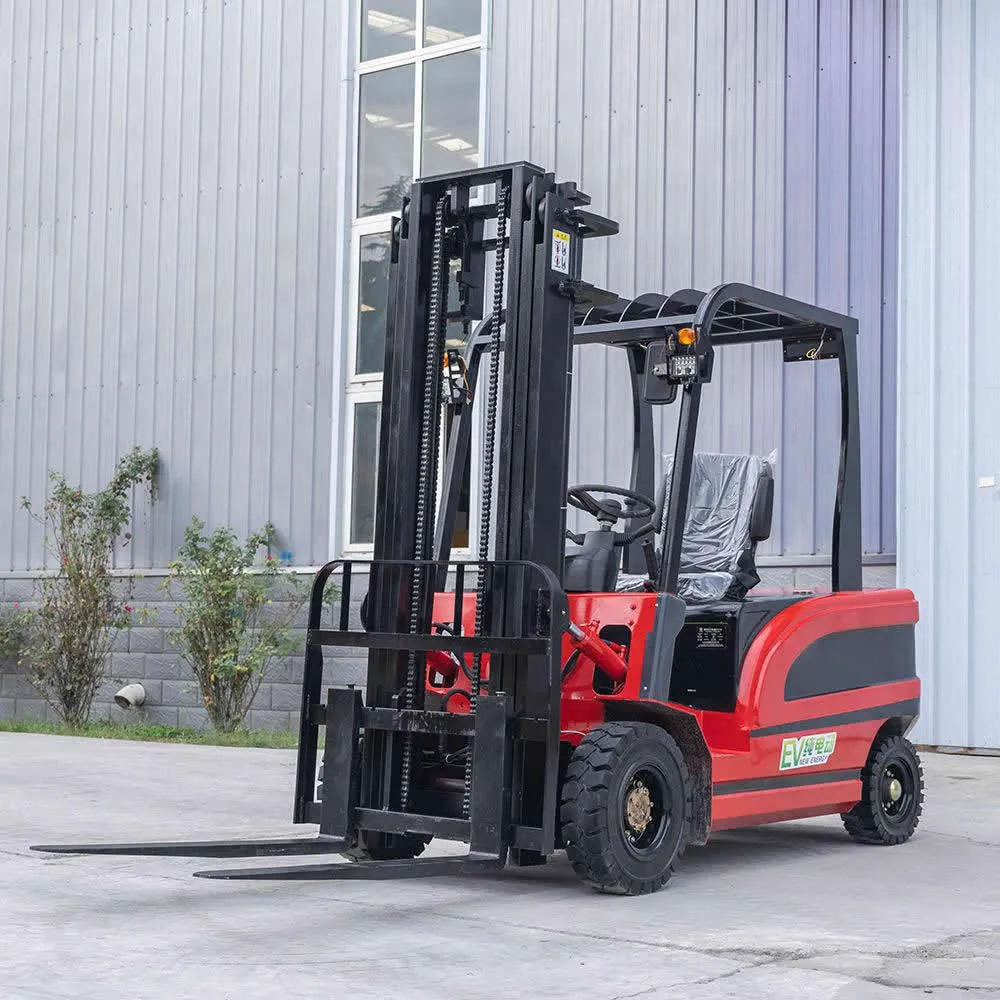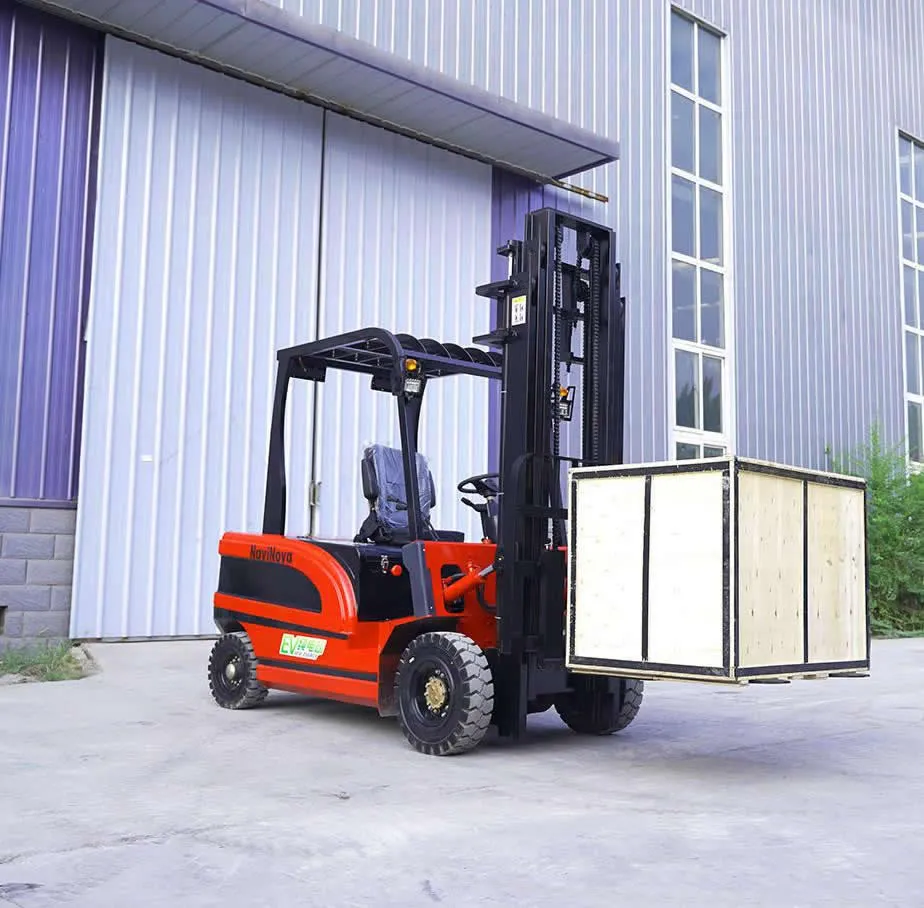Electric forklifts are widely used in warehousing, logistics, and light industry due to their advantages such as zero emissions, low noise, and flexible operation. However, different operating environments (such as indoor and outdoor) have different effects on forklifts: dust, humidity, temperature, and ground conditions can all accelerate component wear or damage. Therefore, post-operation maintenance is crucial, not only extending equipment lifespan but also ensuring safety and improving performance.
The following will systematically introduce post-operation maintenance instructions for electric forklifts, starting with the main components (such as battery, electronic control, hydraulics, and mechanical structure), with special considerations for different environments (indoor/outdoor).

1.1 Battery (Power System)
The battery is the most critical and sensitive component of an electric forklift, and its maintenance is extremely important.
1.1.1 Check Battery Status and Connections
After operation, check the battery voltage, connecting wires, and connectors. Ensure cables are secure and free from overheating. Regularly check remaining battery power to avoid over-discharge. Charging should be performed in a well-ventilated environment using the compatible charger.
For lead-acid batteries, check the electrolyte (battery water) level and add distilled water after use.
Inspect the battery casing for cracks, severe corrosion, or deformation.
1.1.2 Cleaning and Corrosion Prevention
Electric forklifts are primarily designed for indoor operation and are less airtight than rainproof vehicles. Direct water washing can cause water to seep into the base, damaging circuit components. The correct method is to wipe the vehicle surface with a damp cloth, focusing on removing mud, sand, and debris from tire treads and wheel areas.
Always turn off all power before cleaning to prevent accidental activation of control switches or contact of cleaning tools with live parts, which could cause short circuits.
Clean the connection terminals (electrode posts) regularly (e.g., weekly/after each shift) to remove corrosion and treat with an anti-corrosion spray. Regularly check battery terminals for oxidation or looseness, and wipe with a dry cloth to maintain good contact.
Keep the battery and battery compartment clean, free of dust, impurities, and acid residue.
1.1.3 Charging Management
After forklift operation, connect the battery to the charger according to specifications. During charging, certain control circuits (such as the chopper) must be disconnected to avoid overvoltage damage to electronic control components.
For lead-acid batteries, it is recommended to add water after each operation (at the appropriate time and under correct conditions) and avoid over-discharging.
When the forklift is not used for an extended period, the battery should be fully charged and regularly maintained (e.g., recharge every 1–2 months) to prevent sulfation or degradation.
For systems with equalization (balancing) charging functions, perform equalization charging regularly to maintain the health of all cells.
1.1.4 Ventilation and Thermal Management
When using the forklift in poorly ventilated or high-temperature environments (such as outdoors or enclosed warehouse areas), ensure that electronic control components (such as controllers/choppers) have good heat dissipation; install forced ventilation if necessary.
Check that ventilation vents are blocked by dust and debris, especially in outdoor environments or dusty locations.
1.2 Electrical Control System (Controllers, Relays, etc.)
The electrical control system is responsible for the forklift's power regulation, steering control, braking, etc., and is a precision component.
1.2.1 Dust and Contamination Cleaning
After operation and periodically, dust and impurities should be removed from the controller and related circuit components to prevent dust accumulation from affecting heat dissipation or causing short circuits.
Especially after working outdoors or in high-dust environments, pay attention to whether the ventilation openings/heat sinks of the electrical control housing are covered.
1.2.2 Inspect Connection Cables and Connectors
Inspect all cables (power lines, control lines) for wear, damage, or deformation from impact.
Ensure all electrical connector terminals are tight, have good contact, and are free from looseness, arcing, or burn marks.
1.2.3 Carbon Brush and Motor Maintenance (if applicable)
For forklifts using carbon brush motors, the carbon brush wear, spring tension, etc., should be checked periodically (e.g., monthly or as recommended by the manufacturer), and dust inside the motor should be removed.
Check the motor for abnormal noises or overheating, and ensure unobstructed heat dissipation channels.
Clean the commutator surface to ensure good contact.
1.3 Hydraulic System (Mast, Lifting, Tilting, etc.)
Although it's an electric forklift, its lifting/tilting functions are largely hydraulic, making this part of the maintenance crucial.
1.3.1 Hydraulic Oil Inspection and Replacement
After operation, check the hydraulic oil level (usually with the forks down and the mast lowered) and top up to the manufacturer's recommended level.
Replace the hydraulic filter element regularly to prevent impurities and metal particles in the oil from damaging the pump, valves, and cylinders.
1.3.2 Hydraulic System Leakage Inspection
Inspect the hydraulic lines, joints, and cylinders for leaks and seepage, especially at the piston rod and cylinder body interface.
Inspect the mast lifting chain and hydraulic cylinder guides for wear or insufficient lubrication.
1.3.3 Chain and Rail Maintenance
Regularly lubricate the mast chain with grease (chain oil) to ensure smooth operation and reduce wear.
Clean dust and foreign objects from the mast rails (rails) to avoid affecting lifting efficiency or causing abnormal noise.
1.4 Mechanical Structure and Chassis
This part is where the forklift frequently comes into contact with the ground and goods, resulting in the most intense friction.
1.4.1 Cleaning and Inspection
After operation, perform basic cleaning, especially on the forks, wheels, frame, and underside of the vehicle, removing dirt, dust, and debris.
Clean the rails, forks, mast, etc., and check for cracks, deformation, bending, or other structural problems.
1.4.2 Fastener Inspection
Inspect and tighten all bolts and nuts, including fork support bolts, wheel bolts, steering gear bolts, and brake bolts.
Check that the fork lock pins or pins are intact and that the safety pins are secure. 1.4.3 Tire and Rim Maintenance
Inspect tire wear (for solid tires, check for cracks; for pneumatic tires, check if the pressure is within the standard range).
For outdoor operations, tires are more susceptible to damage from gravel and sharp objects. Check rims and wheels for impact deformation.
Clean dust and mud from rims and wheels.
1.4.4 Braking System Inspection
Check the parking brake and service brake for flexibility and reliability. Check the acceleration and braking response of the electric drive system to ensure it can stop stably within a short distance.
If a hydraulic braking system is used, check if the brake fluid is within the permissible range; check for leaks in the brake lines and cylinders.
If the braking system makes abnormal noises or produces a friction sensation, it should be inspected and maintained promptly.
1.4.5 Fork and Lifting System
Chain Lubrication: Apply special lubricating oil to the lifting chain after each shift to reduce wear.
Mast Inspection: Confirm the mast tilt function is normal (meeting the "starting" technical standard), and lower the forks to a safe position 0.2–0.3 meters off the ground.
1.5 Operational Safety Systems
Although not directly related to "mechanical lifespan," safety systems (alarms, lights, control equipment) are a crucial element in ensuring long-term stable operation.
Check the horn, reversing alarm, lights (headlights, taillights), and instruments for proper functioning.
Check the cab controls (levers, buttons, switches) for any sticking or malfunction.
Test the steering system's response, especially its steering agility in emergency situations.
Different operating environments have different effects on forklifts. Below are specific maintenance recommendations based on environmental differences.
2.1 Indoor Deployment (Warehouses, Enclosed Factories, etc.)
Dust Control: In indoor warehouses, especially those with high dust levels (such as warehouses for bulk goods or granular materials), pay special attention to dust accumulation on slides, chains, and electrical control vents. Frequent cleaning (daily/after-shift) and regular lubrication are recommended.
Battery Ventilation: When operating in enclosed spaces, it is recommended to install or inspect ventilation equipment to ensure sufficient heat dissipation for electrical control components (controllers/choppers).
Humidity Management: If the warehouse humidity is high, check for condensation and corrosion on battery terminals, and clean and protect them as needed.
2.2 Outdoor Operations (Factory Areas, Open Docks, etc.)
Rain and Water Stains: After operation, if the forklift has been exposed to water or rain, promptly check the battery compartment, electrical control room, and wiring connections for water ingress, and drain any accumulated water.
Mud and Debris: Outdoor roads may contain mud and gravel. Forklift tires, frames, and chassis are prone to accumulating mud and sand; cleaning frequency should be increased.
Temperature Difference and Thermal Stress: Large fluctuations in outdoor temperature (hot daytime vs. nighttime cooling) place additional thermal stress on the battery and electronic control system. It is recommended to perform thermal management after operation (e.g., allow the system to cool naturally, check the vents) and avoid immediate high-load charging under extreme temperatures.
Ground Impact: Uneven roads, gravel, potholes, and other terrain features can exacerbate impacts to mechanical structures (such as the mast and steering system). Structural inspections should be strengthened (especially wheel hubs, frame welds, and fasteners).

To ensure the above maintenance items are implemented effectively and to maximize forklift life and safety, a systematic maintenance system should be established:
3.1 Daily (Per Shift/Daily) Inspection
Operator Responsibilities: Visual inspection (tires, forks, hydraulics, brakes), cleaning surface dust, checking alarm devices, safety systems, etc.
Check the forms and records to ensure completion each shift.
3.2 Weekly Inspection
Technicians or experienced operators: Inspect battery fluid levels, terminal cleanliness, chain lubrication, fasteners, hydraulic oil levels, braking system, etc.
Perform basic maintenance on critical components.
3.3 Monthly Maintenance
Conduct a more comprehensive inspection of the hydraulic filter and replace it (if necessary).
Inspect the electronic control system, carbon brushes, cooling system, forced ventilation system, and connecting cables.
Lubricate the chain, mast, and bearings.
3.4 Quarterly/Semi-annual/Annual Inspection
Professional technicians (or external service providers) perform systematic maintenance, including battery health checks, equalization charging, hydraulic system pressure testing, and mechanical fatigue checks.
Establish maintenance record files (maintenance logs) to provide a basis for future repairs and parts replacement.
3.5 Training and Feedback Mechanism
Provide regular training to operators, enabling them to understand the importance of these maintenance items and recognize early fault signals.
Establish a feedback mechanism: If operators discover problems during routine inspections, they should promptly report them to the technical maintenance team for timely handling.
Battery Life Degradation: Improper charging (over-discharging, high-temperature charging, lack of equalization charging) is the main cause of reduced lifespan for lead-acid or lithium batteries.
Thermal Stress Damage: Especially in outdoor environments, high temperatures and prolonged loads can cause overheating of electronic control components. Poor heat dissipation may lead to malfunctions.
Mechanical Overload or Impact: Uneven outdoor surfaces or improper operation (such as sharp turns, high-load lifting) may accelerate fatigue and damage to structural components (fork arms, masts, fasteners).
Hydraulic Contamination: If hydraulic oil is not changed for a long time or the filter is clogged, impurities will form, causing wear on pumps, valves, and cylinders.
Safety System Failure: Failure of systems such as alarms, horns, and lights due to dust or loose wiring may pose safety hazards.
For operators, investing in a maintenance system often yields a far greater return than the risks of neglecting maintenance, reducing downtime, extending battery life, and saving on long-term maintenance costs. For the technical team, understanding the different impacts of the operating environment on the equipment and adjusting maintenance strategies accordingly is the core of professional maintenance management.
By establishing a two-tiered maintenance system of "immediate post-operation maintenance + regular professional inspections," the durability and reliability of electric forklifts in various operating environments can be significantly improved.